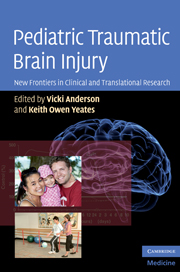Book contents
- Frontmatter
- Contents
- List of contributors
- Acknowledgments
- Introduction: Pediatric traumatic brain injury: New frontiers in clinical and translational research
- 1 Biomechanics of pediatric TBI
- 2 Neurobiology of TBI sustained during development
- 3 Using serum biomarkers to diagnose, assess, treat, and predict outcome after pediatric TBI
- 4 Clinical trials for pediatric TBI
- 5 Advanced neuroimaging techniques in children with traumatic brain injury
- 6 Neurobehavioral outcomes of pediatric mild traumatic brain injury
- 7 Very long-term neuropsychological and behavioral consequences of mild and complicated mild TBI: increased impact of pediatric versus adult TBI
- 8 Neurobehavioral outcomes of pediatric traumatic brain injury
- 9 Neuropsychological rehabilitation in children with traumatic brain injuries
- 10 Psychosocial interventions
- 11 Pediatric TBI: challenges for treatment and rehabilitation
- 12 Integrating multidisciplinary research for translation from the laboratory to the clinic
- Index
- Plate section
- References
Introduction: Pediatric traumatic brain injury: New frontiers in clinical and translational research
Published online by Cambridge University Press: 14 May 2010
- Frontmatter
- Contents
- List of contributors
- Acknowledgments
- Introduction: Pediatric traumatic brain injury: New frontiers in clinical and translational research
- 1 Biomechanics of pediatric TBI
- 2 Neurobiology of TBI sustained during development
- 3 Using serum biomarkers to diagnose, assess, treat, and predict outcome after pediatric TBI
- 4 Clinical trials for pediatric TBI
- 5 Advanced neuroimaging techniques in children with traumatic brain injury
- 6 Neurobehavioral outcomes of pediatric mild traumatic brain injury
- 7 Very long-term neuropsychological and behavioral consequences of mild and complicated mild TBI: increased impact of pediatric versus adult TBI
- 8 Neurobehavioral outcomes of pediatric traumatic brain injury
- 9 Neuropsychological rehabilitation in children with traumatic brain injuries
- 10 Psychosocial interventions
- 11 Pediatric TBI: challenges for treatment and rehabilitation
- 12 Integrating multidisciplinary research for translation from the laboratory to the clinic
- Index
- Plate section
- References
Summary
Introduction
Traumatic brain injury (TBI) is a major public health problem among children and adolescents. Surveillance data reveal that 1 in every 20 emergency department presentations at pediatric hospitals is for a TBI, making TBI more common than burns or poisonings. For children, such injuries represent a common interruption to normal development, with population estimates ranging from 200 to over 500 per 100,000 a year, and with well-established variations across age and gender (Crowe et al., in press; Langlois et al., 2006). The majority of TBI in children and adolescents are mild, typically with few long-term consequences; however, a significant proportion of children will suffer more serious injuries and will experience a range of residual physical, cognitive, educational, functional, and social and emotional consequences, requiring the lifelong involvement of health professionals across a range of disciplines and leading to a significant social and economic burden for the children's families and for the community more broadly (Cassidy et al., 2004).
This book, New Frontiers in Pediatric Traumatic Brain Injury, aims to evaluate what we have learned about TBI in childhood to date and, perhaps more importantly, to articulate the challenges we face and how we should go forward in the future. Over the past two or three decades, researchers and clinicians working with children with TBI have become aware that injuries to the developing brain cannot be understood or treated in exactly the same manner as those occurring in adulthood.
- Type
- Chapter
- Information
- Pediatric Traumatic Brain InjuryNew Frontiers in Clinical and Translational Research, pp. 1 - 6Publisher: Cambridge University PressPrint publication year: 2010
References
- 6
- Cited by



